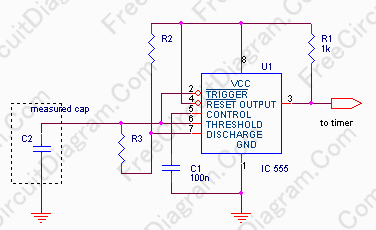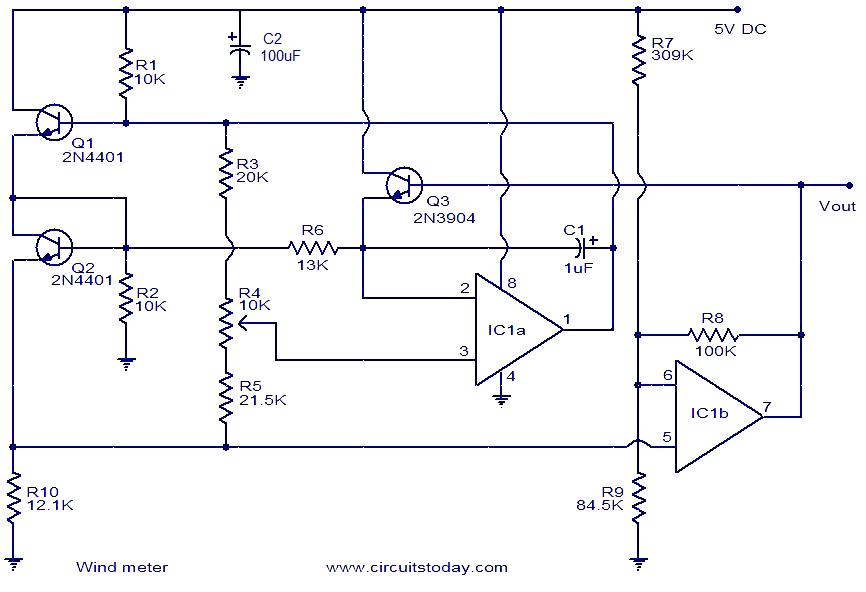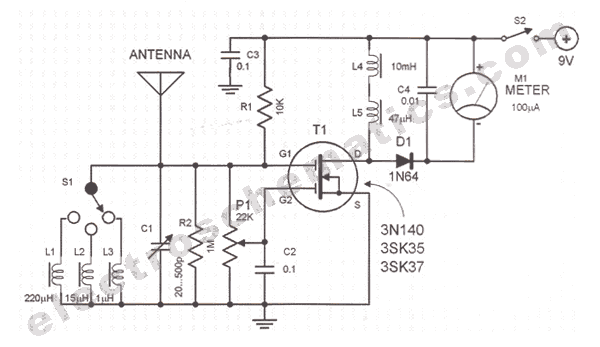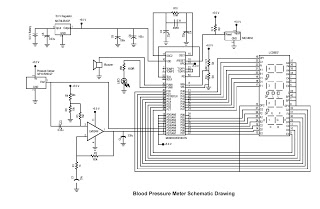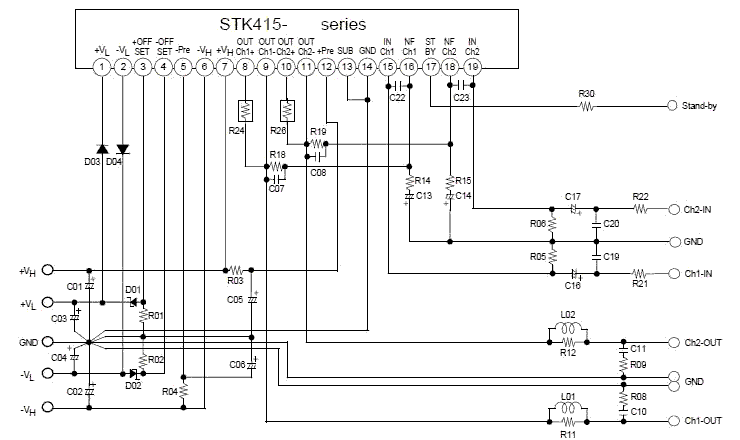
Stereo balance meter
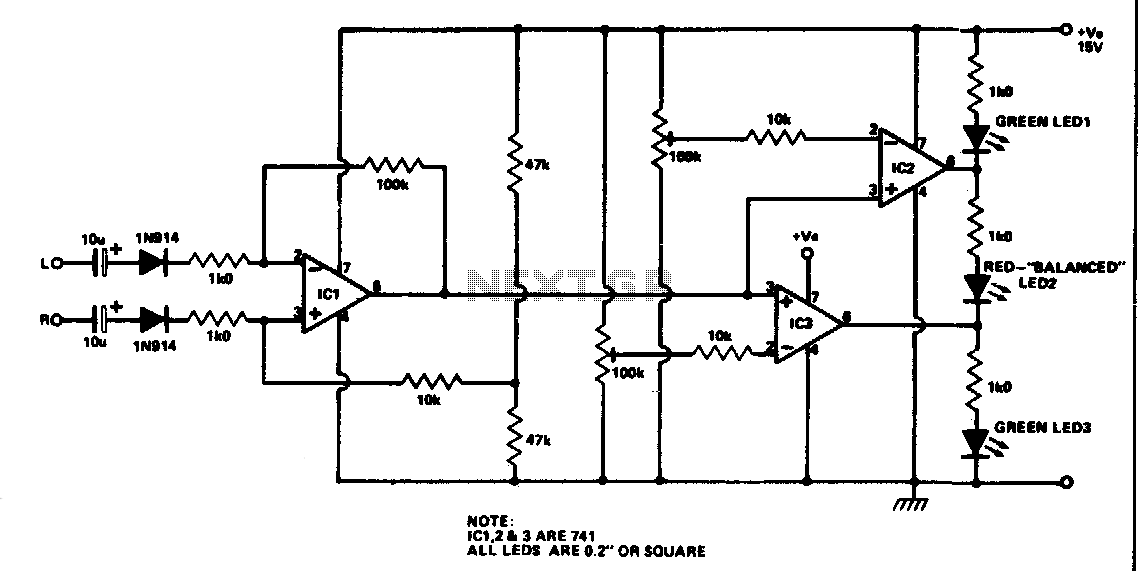
Outputs from each channel are fed to the two inputs of IC1 connected as a differential amplifier. IC2 and IC3 are driven by the output of IC1. The output of IC1 is connected to the non-inverting inputs of IC2 and IC3. If the output of IC1 approaches the supply rail, the outputs of IC2 and IC3 will also go high, illuminating LED3. This occurs when the right channel is dominant. Conversely, if the left channel is dominant, the outputs of IC2 and IC3 will be low, illuminating LED1. When both channels are equal in amplitude, the outputs of IC2 and IC3 will be high and low, respectively, activating LED2.
The circuit described utilizes a differential amplifier configuration to compare the outputs from two audio channels. The first integrated circuit (IC1) functions as a differential amplifier, processing the audio signals from the left and right channels. The output from IC1 is critical, as it determines the behavior of the subsequent integrated circuits, IC2 and IC3, which serve as indicators of channel dominance.
The non-inverting inputs of IC2 and IC3 are connected directly to the output of IC1. This setup allows IC2 and IC3 to respond to the differential voltage produced by IC1. When the output of IC1 approaches the positive supply voltage, indicating that the right channel signal is stronger, both IC2 and IC3 will output high signals. This condition activates LED3, signaling that the right channel is dominant.
In contrast, if the left channel signal is stronger, the output of IC1 will be lower, causing IC2 and IC3 to output low signals. This will illuminate LED1, indicating the left channel's dominance. The circuit is designed to provide a visual representation of channel strength through the LEDs, enhancing user experience by clearly indicating which channel is leading.
In scenarios where both channels are equal in amplitude, the output from IC1 will yield a balanced differential signal. This results in IC2 outputting a high signal while IC3 outputs a low signal, which activates LED2. This feature allows users to easily discern when both channels are balanced, providing a comprehensive visual feedback mechanism for audio signal management.
Overall, this circuit design effectively combines audio processing with visual indicators, making it a valuable tool for monitoring audio channel performance in various applications.Outputs from each channel are fed to the two inputs of ICl connected as a differential amplifier. IC2 and 3 are driven by the output of ICl. Output of ICl is connected to the noninverting inputs of IC2 and 3. If the output of ICl approaches the supply rail, the outputs of ICs 2 and 3 will also go high, illuminating LED3. This would happen if the right channel were dominating If the left channel was dominant, the outputs of ICs 2 and 3 would be low, illuminating LED1. If the two channels are equal in amplitude, the outputs of ICs 2 and 3 would be high and low respectively, lighting up LED2.
The circuit described utilizes a differential amplifier configuration to compare the outputs from two audio channels. The first integrated circuit (IC1) functions as a differential amplifier, processing the audio signals from the left and right channels. The output from IC1 is critical, as it determines the behavior of the subsequent integrated circuits, IC2 and IC3, which serve as indicators of channel dominance.
The non-inverting inputs of IC2 and IC3 are connected directly to the output of IC1. This setup allows IC2 and IC3 to respond to the differential voltage produced by IC1. When the output of IC1 approaches the positive supply voltage, indicating that the right channel signal is stronger, both IC2 and IC3 will output high signals. This condition activates LED3, signaling that the right channel is dominant.
In contrast, if the left channel signal is stronger, the output of IC1 will be lower, causing IC2 and IC3 to output low signals. This will illuminate LED1, indicating the left channel's dominance. The circuit is designed to provide a visual representation of channel strength through the LEDs, enhancing user experience by clearly indicating which channel is leading.
In scenarios where both channels are equal in amplitude, the output from IC1 will yield a balanced differential signal. This results in IC2 outputting a high signal while IC3 outputs a low signal, which activates LED2. This feature allows users to easily discern when both channels are balanced, providing a comprehensive visual feedback mechanism for audio signal management.
Overall, this circuit design effectively combines audio processing with visual indicators, making it a valuable tool for monitoring audio channel performance in various applications.Outputs from each channel are fed to the two inputs of ICl connected as a differential amplifier. IC2 and 3 are driven by the output of ICl. Output of ICl is connected to the noninverting inputs of IC2 and 3. If the output of ICl approaches the supply rail, the outputs of ICs 2 and 3 will also go high, illuminating LED3. This would happen if the right channel were dominating If the left channel was dominant, the outputs of ICs 2 and 3 would be low, illuminating LED1. If the two channels are equal in amplitude, the outputs of ICs 2 and 3 would be high and low respectively, lighting up LED2.
